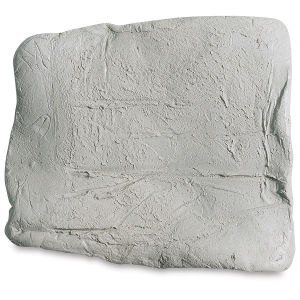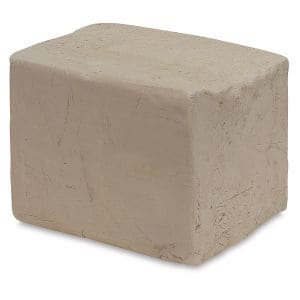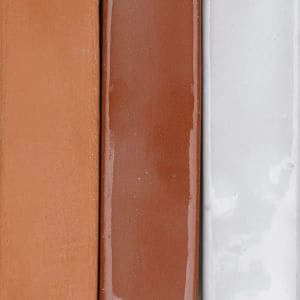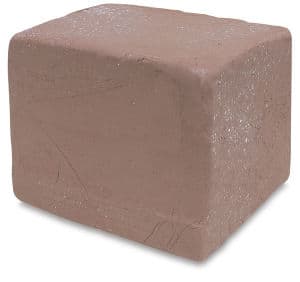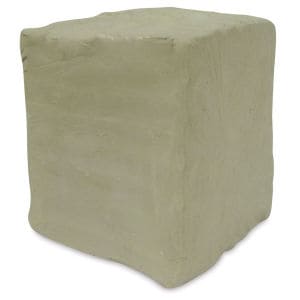Your cart is currently empty!
Best Clay for Handbuilding – Tips on Choosing Pottery Clay
Published:
Last Updated:
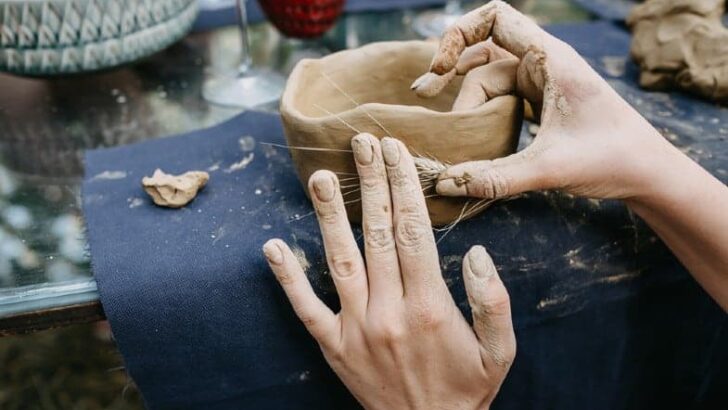
Affiliate Disclaimer
As an affiliate, we may earn a commission from qualifying purchases. We get commissions for purchases made through links on this website from Amazon and other third parties.
If you are making pottery without a wheel, you may be wondering about the best clay for handbuilding. Pottery clay for handbuilding needs to have certain properties. In this article, I will look at what those properties are and which clay you will find them in.
The best clay for handbuilding is stoneware or earthenware clay with added grog. Ideally, handbuilding clay is plastic and strong. Because it is less plastic, porcelain clay is harder to use for handbuilding if you are a beginner. Paper clay which contains fiber is also good for handbuilding pottery.
There are very many different brands of clay on the market. Clay is produced by lots of different manufacturers. And what’s more, the brands of clay that you find locally will vary between country and region.
However, choosing a clay for handbuilding can be simple. When you are handbuilding pottery you need your clay to have two main properties. Let’s have a look at what these properties are. And then take a look at which clay will meet these needs best.
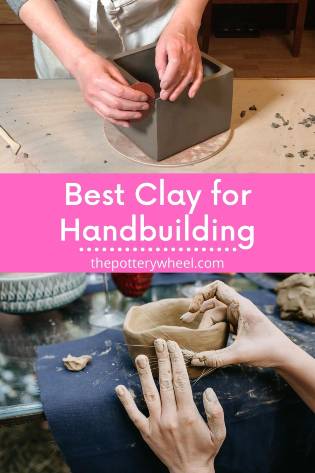
The Best Clay for Handbuilding
There are a few different qualities that you need to look for in clay for handbuilding. The two main qualities of plasticity and strength:
Plasticity
Plasticity refers to how easily you can shape clay. But also, and more importantly, plasticity is the clay’s tendency to keep that shape, once it has been molded. A plastic clay will stay in the shape that a potter has fashioned it into.
Some clays are more elastic and will return to their original shape after being molded. A bit like a piece of stretched elastic.
Plastic clay by contrast will stay in the form that it has been given. This is a useful property for pottery clay.
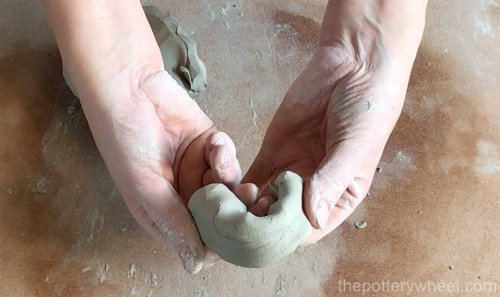
Another quality of plastic clay is that it will bend without cracking. Imagine taking a slice of clay and wrapping it around a pencil. If the clay is very dry, it may crack because there is insufficient water content.
However, if it is moist enough and it still cracks, then this indicates that the clay is not especially plastic.
It’s easy to see why plasticity is important for handbuilding pottery. Firstly, ideally, you will want your pottery to retain its shape once it has been formed. And secondly, handbuilding pottery often involves bending the clay. Think of making a coil pot. Each coil is bent around the side of the vessel. Ideally, you want to be able to bend your coils without the clay cracking as you work.
Strength
Strength in pottery clay refers to how much the clay can hold itself up once it has been shaped. Strong clay will be able to support itself well. Less strong clay will buckle and slump under its own weight when it has been formed.
Again, this is an important factor for hand building. As you add clay to your form, you want the structure of the piece to be able to support itself.
One of the factors that affect the strength of clay is how much grog it contains.
Grog is a granular, gritty material that is added to clay to give it additional strength. It is normally clay that has been fired so that it is ceramic. Then ground up into granules of a particular size.
Grog comes in different sizes and adds strength to clay by acting a little like internal scaffolding. The larger the size of the granules the more support it offers. Sand is also used as grog in clay.
Because grog has a granular quality, it gives clay a gritty texture. Sometimes called ‘tooth’. This can feel quite uncomfortable if you are throwing your pottery on the wheel. As the clay slips under your hands, the grog rasps your skin. Ouch!
However, this is not a problem if you are hand building. In fact, because it adds strength the best clay for handbuilding generally does have quite a high grog content.
Some Suggested Clay for Handbuilding:
Here are a couple of clay bodies often used for handbuilding pottery.
These two clay bodies both have strength and plasticity. And there are other factors you might want to consider.
Other Factors to Consider
In addition to strength and plasticity, there are a few other factors to consider when choosing your clay. These are:
Firing Temperature
Different clay types of fire at different temperature ranges. Broadly speaking, these temperature ranges are low fire, mid-fire, and high fire. These are the temperatures that each of these ranges covers:
| Temp range | Temp Fahrenheit | Temp Celcius |
|---|---|---|
| Low Fire Mid Fire High Fire | 1830-1940 2157-2264 2305-2381 | 999-1060 1186-1240 1263-1305 |
When you choose your clay for handbuilding you might need to consider what kind of kiln you have access to. For example, perhaps you are having your work fired in a local community kiln at a craft center. You need to check with them what temperature they fire to. If they fire in the low fire range, then it would be best to use a low fire clay body.
But if you have access to a kiln that fires in the mid-range, then you should avoid low fire clay. Low fire clay that is fired at mid-fire temperatures is apt to crack, break, or bloat.
Color
Clay bodies come in a variety of different colors. These range from white, tan, orange, red, brown, buff, grey, and black. Some clays have consistent color, and other clays can look speckled.
It’s worth remembering that some clays look a different color once they have been fired. For example, often a buff/brown clay will look off white or beige when fired.
What Finish? Smooth or Coarse
Whilst grog adds strength to clay, it also makes the texture of the clay grittier. Just how gritty it looks and feels depends on the amount of grog used. It also depends on the size of the grog granules, also known as its mesh size.
The larger the mesh size, the grittier the clay will look and feel.
Functionality
What do you want to use your handbuilt pottery for? If your work is going to be decorative and non-functional, then it does not need as much strength.
On the other hand, you may want to use your pottery for food or drink. If that’s the case, it’s best to go for a clay that will survive a few knocks and bumps. Some clay bodies are tougher when they are fired than others. For example, stoneware is stronger than earthenware. And porcelain, though refined-looking can be even harder than stoneware.
On that note, let’s have a look at these different types of clay. And consider which of them is best for handbuilding.
Best Clay for Handbuilding – What are the Options?
There are lots of different brands of clay produced by different manufacturers. This can feel a bit overwhelming when you first start to consider what type of clay to buy.
The other complicating factor is that different countries and regions sell clay by different producers.
This is partly because clay the raw materials of clay are mined from the ground and then processed. And whilst you can ship clay, it’s heavy and expensive to transport.
So, the clay you have available is likely to be specific to your country or region.
However, there is a simple way to decide which clay to choose. Although there are lots of clay manufacturers, there are really 3 main types of clay.
The best thing to do is decide which type of clay will suit you the most. Once you know which type of clay you want, you can choose between brands.
So, what are the different types of clay, and which is best for handbuilding?
Types of Clay for Handbuilding
Broadly speaking, there are 3 different types of clay. They are:
Let’s have a look at the differences between these clays. And then consider which will suit you best for handbuilding pottery without a wheel.
Earthenware Clay
Earthenware clay is a low fire clay. That means that when it is fired, it is still a little bit porous.
During the firing process, some ingredients in clay, namely silica, melt and form glass. Once the fired pottery cools the glass content in the clay is part of what makes it non-porous.
Earthenware clay contains less of the glass-forming ingredients than other clay bodies. This is part of the reason why it is still quite porous once it has been fired.
As such it needs to be glazed to make it suitable for dinnerware and waterproof pottery like vases.
One of the most well-known earthenware clays is terracotta, which has its distinctive rich red color. However, earthenware clays can be in a range of colors. These include white, yellow, tan, buff, and orange.
Generally speaking, earthenware clay is very plastic.
This means it is easy to shape and will retain the form it is given by a potter. When it is moist it can feel smooth and a bit sticky.
Earthenware Clay and Handbuilding
In spite of its stickiness, earthenware clay is quite easy to use and is a good option for handbuilding pottery. It feels nice to work with and it will keep its molded shape well.
Earthenware clay can feel quite soft. So, it’s helpful to choose a brand that contains some grog in it. The coarseness of the grog will depend on how gritty or smooth you want your pottery to be.
Most manufacturers will state whether the grog is fine, medium, or coarse in their description of the clay body.
Earthenware clay, with added grog or sand, is a good option for hand building. Especially if you are looking for that lovely red color that you get with terracotta.
Limitations of Earthenware Clay
Because fired earthenware is still relatively porous, it is also not especially strong when it is fired. It tends to chip easily and needs to be handled with a bit of care.
When it’s glazed, it can be used as functional pottery, such as dinnerware. However, it is not as tough as other clay bodies. So, when you are washing your earthenware mugs and plates, you need to be careful not to ding them together.
By contrast, stoneware clay is as its name suggests, quite tough when it’s been fired. Let’s have a look at stoneware clay now as an option for handbuilding.
Stoneware Clay and Handbuilding
Stoneware clay can be fired at higher temperatures than earthenware clay. Here is a short video in which stoneware clay is being used to hand build a pinch pot.
Different types of stoneware clay will mature at different temperatures. Clay is said to have matured when it has become as dense and strong as it can during firing.
Some stoneware matures in the mid-fire range, other stoneware clay matures in the high fire range. Either way, stoneware clay that has been fired to the right temperature is less porous and stronger than earthenware clay.
That means stoneware is a good choice if you are making functional pottery.
But what is it like to use? And is stoneware clay a good choice for handbuilding pottery?
Generally speaking, stoneware clay is plastic and easy to shape. It is less sticky than earthenware clay but just as cooperative. So, for that reason, it’s a good choice for handbuilding pottery. Again, like earthenware, using a stoneware clay with added grog will give your clay extra strength.
So, if you are planning to handbuild larger forms, then a stoneware clay with added grog is a good idea.
Remember, grog helps the clay support itself as you build.
And bigger pieces of pottery will support their own weight more successfully if they contain some grog.
If you want to watch a step-by-step video of making a pinch pot check out my YouTube channel. In this video, I’m using stoneware clay to make a pinch pot. This particular clay is a buff stoneware, I like it because although it contains grog for strength it can be smoothed out well with a rib tool.
I tend to think of stoneware as being the workhorse of the clay world. It’s versatile, reliable, and strong. By contrast, porcelain is more high maintenance and demands a bit more special treatment. So, let’s have at porcelain and handbuilding….
Porcelain Clay and Handbuilding
Porcelain clay is a high fire clay. Once it is fired to maturity it is very dense, hard, and non-porous.
Nevertheless, it can also be formed to make very thin, refined-looking pottery. Because of its high glass content, thin-walled porcelain pieces can look translucent.
Porcelain is stretchy and bendy to work with and can be shaped into thin detailed forms. However, porcelain is not plastic, and it is harder to get it to keep the shape you have given it. It is also not especially strong.
Porcelain is more likely to slump, collapse, or flop as you are working with it. And for that reason, it is often not the first choice when handbuilding pottery.
This is particularly the case if you are new to handbuilding. Porcelain requires a bit more coaxing to get it to cooperate and this makes it harder to work with.
In addition to being a bit floppy, porcelain loses moisture fast. That means you need to be quick, to avoid your piece drying out as you work.
Handbuilding is generally a more time-consuming process than wheel throwing. It takes longer to make a coil pot than to throw one on the wheel. So, porcelain, which requires a quick touch is not ideal.
Nevertheless, some experienced potters do use porcelain for handbuilding.
The general advice when using porcelain for handbuilding is to keep your pieces smaller.
That way, the porcelain does not have to support as much weight. And you can work faster before the clay has become too dry.
Options with Porcelain
There are clay bodies that are a mixture of porcelain and stoneware. These are sometimes called hybrid clays. A porcelaneous stoneware clay has some of the strength and plasticity of stoneware. And also has some of the refined delicacy of porcelain.
If you want to handbuild with porcelain, then a hybrid stoneware/porcelain mix would be a good option. Nevertheless, because it contains porcelain, it is still a little harder to manage for beginners.
A solution to this would be to use a grogged porcelain. Adding grog to porcelain gives it additional strength, and prevents it from drying out so quickly.
However, even with a fine grog, porcelain is more challenging to use. And generally, not recommended as a first choice if you are new to handbuilding and pottery in general.
Nevertheless, some experienced potters make exquisite handbuilt porcelain pottery. A good example is Antoinette Badenhorst who specializes in handbuilding with porcelain.
Paper Clay and Handbuilding
Paper clay refers to clay that contains added fiber to give it extra strength.
The term paper clay suggests that the fibers used are paper-based. However, this is not always the case. Some paper clay contains cellulose-based paper fibers. Whilst others use nylon and cotton fibers.
The name ‘paper clay’ is simply an umbrella term, that refers to clay that contains added fiber. Whether or not the fiber used is paper-based.
One advantage of synthetic fiber like nylon is that the clay has a longer shelf life. Fibers made out of organic material like paper or cotton can rot in moist clay if left for too long. Nylon fiber does not break down and rot in the same way.
Adding fiber of any kind to clay works a little like grog in that it gives the clay additional strength. However, unlike grog, the fibers burn out of the clay body when it is fired.
Not all clay that is sold as “paper clay” can be fired, so it’s important to check the manufacturer’s specifications.
You can buy clay that already has added fiber. Alternatively, some potters will add fiber to their existing clay. It can be added to earthenware, stoneware, or porcelain. It is often possible to buy fibers from a local ceramic supplier.
Final Thoughts
Brands of clay vary from country to country, and manufacturers will have their own names for their ranges.
However, the best clay for handbuilding is either stoneware or earthenware. Added grog will make either of these clay bodies even easier to use. Porcelain is an option if you like a challenge, but in general, it is not the easiest clay if you are new to handbuilding.

